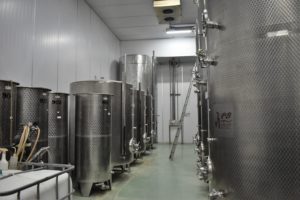If you go to the supermarket, chances are you won’t find a bottle of Thai wine, as 75% of the wine produced in Thailand is for the domestic market with the rest going to Japan and New Zealand.
As well as producing wine, many wineries offer tours and we chose to visit “PB Valley Khao Yai Winery”:https://www.khaoyaiwinery.com/ whilst staying at the “Lala Mukha Tented Resort”:https://www.silvertraveladvisor.com/review/accommodation/195354. The logo of the winery includes the Giant Hornbill, the symbol of “Khao Yai National Park”:https://www.silvertraveladvisor.com/review/attraction/195356, which we’d visited the day before.
The first vines were planted in 1989, but it was another 9 years before production began in earnest. It was established by Dr Piya Bhirombhakdi who in 2011, was awarded the honour of Wine Pioneer of South East Asian Region. It appeared we’d chosen the right winery to visit.
We had a pre-booked tour for 2.30pm and arriving early gave us chance to look round the shop (which sold their wine, snacks and gifts), duck pond and huge enclosure with rabbits and chickens. There were also outdoor market stalls selling a range of fresh produce and a flower garden which had an enormous tee-pee in the centre of all the colourful flower beds. A stream was full of fish which people were feeding and a smart-looking restaurant overlooked the vineyards.
We set off on two electric open-sided vehicles taking around 20 passengers each with a guide. We were surprised the tour was in English and Thai, as we appeared to be the only western tourists.
We drove through various fruit orchards which were all pointed out before our first stop where grapes were being grown under shade and netting as they were for eating. We were able to get off and there was plenty of time for photographs and noted the stern warnings of a 2,000 Baht fine if we picked the grapes. We continued through vines which included Tempranillo from Spain, Shiraz, Colombard and Chenin Blanc.
Our next stop was an area with steel and large oak tanks used in the fermenting process and an area containing lots of small oak barrels for aging the wine. At each stage there was a simple description of the process and time for photos.
In the tasting room, we saw bottles graded into the three categories: Sawasdee, PB Reserve and Pirom Khao Yai Reserve before sampling four wines: a Chenin, rose, Shiraz and Tempranillo. We were surprised that the latter two were 14 and 14.5% ABV respectively. We preferred the middle two, but the white might have been better, slightly more chilled. There was also a plate of crackers and cheese and grape juice was available for non-drinkers and children. It was all beautifully done and managed and there was no scrum down. We left ensuring we avoided a 1,000 Baht fine for stealing a PB Valley etched tasting glass.
Back on the bus, we were returned to the main area, where our ticket gave us a discount in the shop.
The tour, including tastings, lasted around an hour and cost 350 Baht (£8.75) without any fines you might incur.










